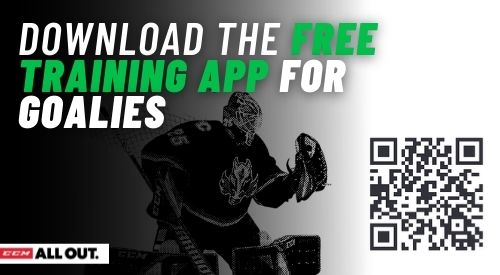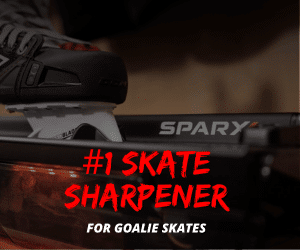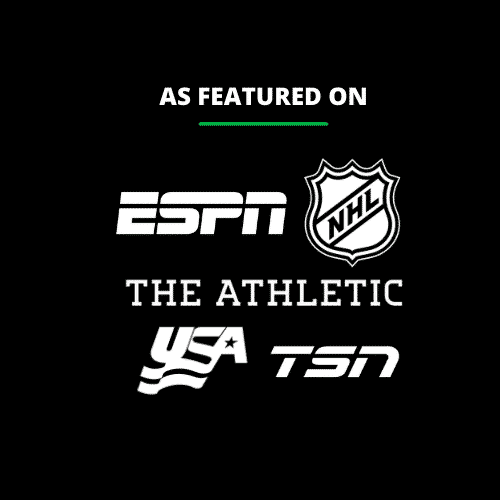The Reverse VH, or RVH, stands for Reverse Vertical Horizontal. Also commonly referred to as simply, “the reverse”, the RVH is a technique used by goalies to play when near the posts of the net. The RVH has exploded in popularity over the past number years in the NHL. The RVH is one of those terms that gets thrown around on every broadcast hundreds of times.
What does RVH in goaltending stand for?
The RVH, as far as goalies are concerned, stands for Reverse Vertical Horizontal. Reverse Vertical Horizontal relates to a goalies leg positioning on the post. The acronym “RVH” stems from “Vertical Horizontal”, which meant a goalies post side leg was vertical, inside leg horizontal. Reverse simply means the opposite.
If you’re following closely, that means the post side leg is tightly sealed on the ice (not vertically positioned as in the VH) with the inside leg acting as a pivot.
Playing in the RVH allows goalies, especially larger goalies to use their body very efficiently during plays in the dead angle area and wrap arounds behind the net. In this article, we’ll cover RVH drills, common misconceptions about the RVH, and use cases (and mis-use cases). The RVH is a position that can significantly improve your play as a goalie, but it should be used with caution. We’ll cover some of these mis-use cases below.
Put a goalie coach in your pocket with the Goalie Coaches training app, built specifically for hockey goalies. The Goalie Coaches app has been used at every level of play, up to the NHL. Unlock hundreds of drills, game specific scenarios, and more inside the free app, today.
What does the RVH look like?
When a goalie is in the RVH position, their leg on the post side lies flat on the ice, with the skate blade touching the post. On the left post, the left leg is flat on the ice with the pad sealing. On the right side of the net, the goalies right leg is flat.
Let’s take a deeper look at the Reverse VH. The Reverse Vertical Horizontal is highly effective when used correctly. When overused, or used in the wrong situation, shooters can exploit the top half of the net very easily.
In the photo below, Frederik Andersen demonstrates a perfectly executed RVH. The photo was taken while Andersen was in motion, so his head is towards the ice and his upper body is a bit slouched.

RVH Video Demonstrations for Goalies
In the video below, Filip Gustavsson presents a textbook example of how the RVH position should be executed with proper foot positioning on the post. A big problem with RVH use amongst goalies, professional and amateur alike, is that they create future problems for themselves starting the minute they enter the position. Proper foot positioning on the post is critical to this techniques success.
In the next video below, we’re demonstrating proper RVH play on the blocker side.
In the second video, Michigan Tech Goalie Coach Jamie Phillips explains the Golden Triangle and how it comes into play when using the RVH position.
The video below shows Joey Daccord, goalie for the Seattle Kraken, returning to the post in the RVH from outside the net. While this is not an ideal situation to be in, it’s a great way to effectively return to the RVH for more post play.
The Reverse VH, RVH Goalie Technique Explained
We’ll cover the RVH position in depth. Below, we’re going to discuss how to properly execute the reverse vertical horizontal, as well as how the RVH compares to the VH position.
How do you use the RVH in goaltending?
To most effectively use the RVH technique for goalies, the post leg must lie flat on the ice with the skate blade touching the post. For maximum post seal, the toe of the goalie pad and the goalies skate will cradle the post itself. The goalie will create a vertical seal along the post with their glove or blocker arm, while maintaining a tall posture as to reduce exposure in the upper half of the net.
The majority of goals scored from the RVH position.
When should I use the RVH?
The RVH should be used sparingly and only in a few select situations.
- When moving from post to post in a “wrap around” situation
- When a play is within a stick length of the goalies net, along the goal line or within several feet of it
When goalies should avoid the RVH
The RVH is one of the most overused positions in all of goaltending. As a result, hundreds of goals that otherwise would not have gone in, have been scored over the course of just a few years at the NHL level.
- Do not use the RVH when the puck is further than 1-2 stick lengths of the goalies net
- Do not use the RVH when the puck and attacking team are inside the corner
- Do not default to the RVH just because the puck is behind the net
As a general rule of thumb, if you have the opportunity to re-gain your feet instead of remaining in the RVH, you should do so. Holding your feet provides more of an advantage should there be an opportunity for quicker lateral movements required as a scenario develops.
One example of this is shown in the video below. This video also demonstrates the type of analysis content you’ll find in the training app we’ve built for goalies. Want more of it? Download the app and start studying the position!
Downsides of the RVH
There are many risks associated with the RVH position. Here are a few of the most notable.
- The RVH is damaging to a goalies hips, overuse can lead to injury
- The RVH is a challenging position to recover from, leading to an increase in slot scoring opportunities
- The RVH is challenging to control rebounds from, especially when pucks are shot to the inside of the goalies body
- The RVH exposes a large amount of net above the goalies head and post side shoulder
- The RVH reduces glove and blocker mobility, taking these hands out of normal position
Technique is of the essence when utilizing the RVH. There are a number of risk factors when a goalie is in the RVH. The three most common risk factors in the RVH are:
- Improper Post Seal
- Upper Net Corner Exposure
- Recoveries from the RVH to Backside or Slot Shots
Improper post seal and upper net corner exposure are illustrated in the graphic below.
Whenever the RVH is used, there must be a proper seal from the #1 threat area, which is the skate on the post. The toe of the goalies skate and the toe bridge of the pad should form a tight seal of the post, eliminating any threat of a tight wrap around into the side of the net.

Recoveries out of the RVH also pose a challenge for goalies. In the illustration above, we show Phillip Grubauer preparing to exit the RVH position to a shot on the same side of the rink. One thing goalies must keep in mind when utilizing this position is in scenarios like the Royal Road, when the puck is crossing the center of the net.
In these cases, your recovery is further impeded because you do not have time to re-gain your feet. This can pose problems for goalies and it’s the result of a lot of goals at every level of play.
Below is a video from our friends at Goalcrease in Edina, MN and Jeff Hall explaining the RVH as it relates to goalies. In this video, you’ll hear Jeff also refer to the RVH as the “post-lean” position.
Whatever you decide to call it, build an understanding of when to use it and when not to use for best results on the ice.
Keeping an Active Stick in the RVH
Goalies must understand that when they are in the RVH position, they are in a vulnerable place. As such, they should utilize their stick to help buy them time if and when they are forced to leave this position.
Below, we see Carter Hart of the Flyers demonstrating an active stick while in the RVH on his glove side. In this case, his stick showing backhand allows him to disrupt a pass across the crease, or more likely, to push a puck back behind the goal line.
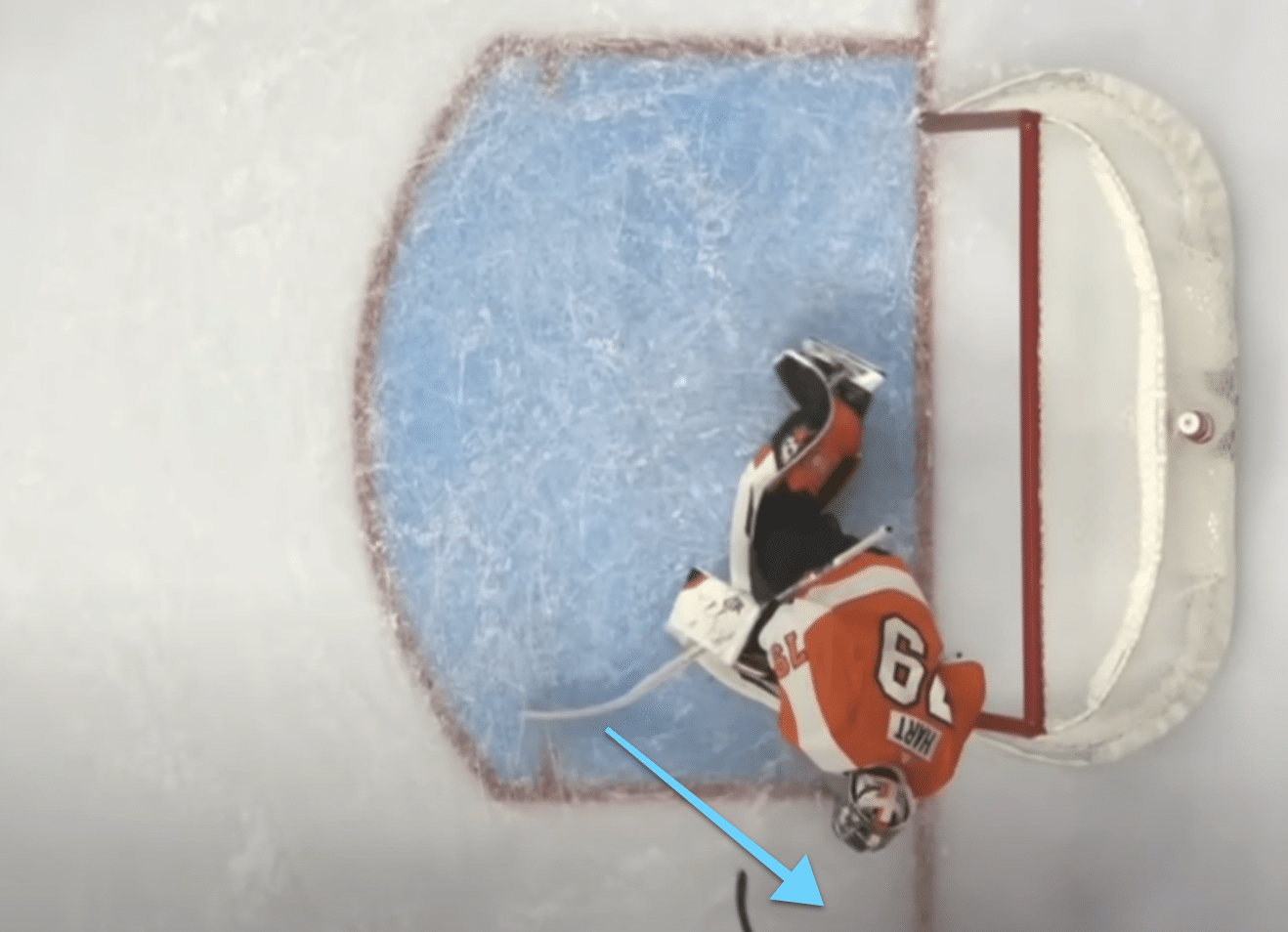
Alternatively, goalies can keep their stick in a normal position. One advantage of the normal stick position is that the odds for an errant puck hitting the goalies backhand and trickling through the five hole. In the image below, we see Carter Hart utilizing normal stick position in the RVH.
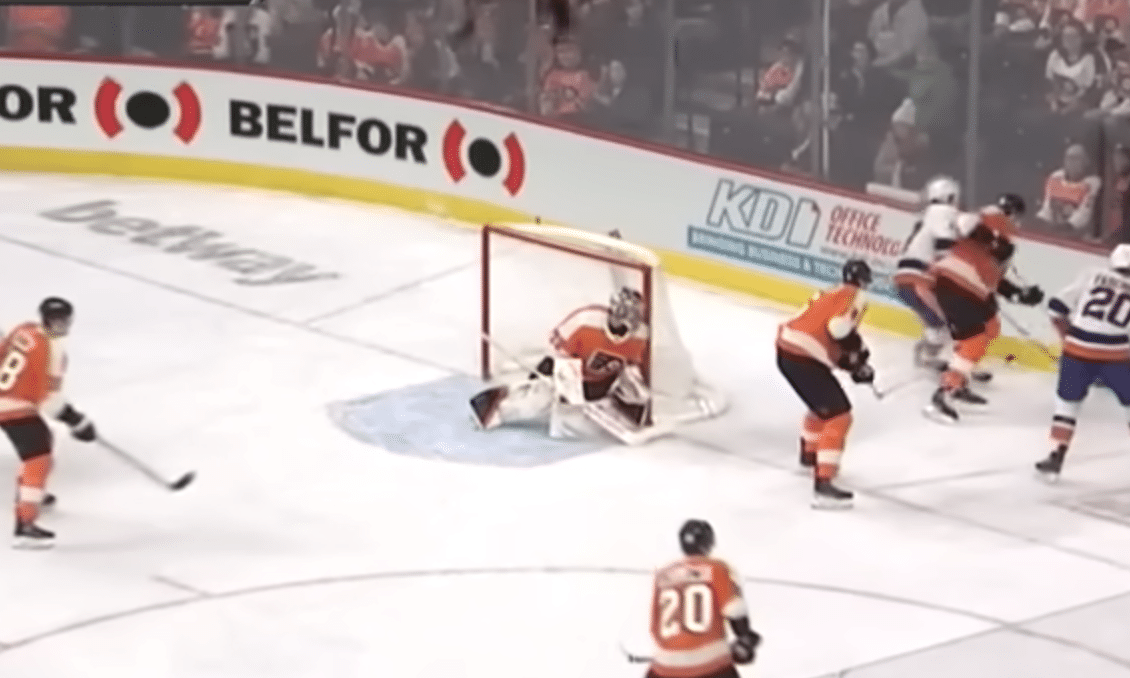
Understanding When To Use And When Not To Use The RVH
Goalies in today’s game pick up on and adapt to new concepts quicker than every before. The RVH is no different. In fact, a large percentage of goalies probably saw their favorite NHL goalie in this position and decided to give it a try, before ever knowing what it was called.
The RVH position works extremely well in wrap around situations for a couple reasons. First, it’s quick and efficient. Moving from a standing position either on the post or in the crease to the RVH is a matter of one movement. Second and more importantly, it provides excellent coverage not given from a standing position.
When used correctly, the RVH takes away virtually every hole a shooter would have to shoot at.
It is critical, however, to note that the RVH position should only be used in certain placements of the puck.
When a shooter is very close to both the net and the goal line, the RVH takes away more than it gives. On the flip side, as a shooter nears the hash marks and has the opportunity to move towards the slot, a goalie is challenged on both the near pipe shoulder and glove sides.
Related: Foot positioning in the RVH
Scenario 1: Puck in the corner
Let’s take a look at this clip of Toronto Maple Leafs goalie Frederik Andersen. The puck moves into and out of the corner, a position some goalies prefer the RVH, behind the net and into the slot.
Should Andersen have used the RVH in this situation?
Many people would argue for both sides. However, as the RVH becomes more and more mainstream, shooters have started to exploit it’s overuse. By remaining in a standing position with no direct wrap around threat, Andersen is able to quickly challenge a shooter in the slot area and make an excellent glove save.
Had he been in the RVH position, instead of gaining depth quickly on his feet (simultaneously cutting down large amounts of angle: see box control for goalies) Andersen would have had to bump off of the post. This would have put him in the butterfly position and allowed the shooter a much larger target to shoot at.
Scenario 2: Shooter directly behind the net
In this clip of a game situation training scenario, the shooter is directly behind the net with his/her choice of options.
Should the goalie use the RVH here, or stay on their feet?
In this case, the immediate threat is a wrap around attempt. As a goalie, facing these immediate threats is our first priority. Second, playing situations in such a way that we are not out of position for secondary/tertiary threats.
Learning how to effectively seal the post, yet maintain control of your body is imperative for any goalie who plans on implementing the RVH in their game. The goaltender should quickly and efficiently seal off the first target area, the post (if you haven’t read our foot positioning in the RVH article yet, do it) while simultaneously moving into a complete post seal / active stick position with his/her body.
RVH Drills for Goalies
We’ve got a completely separate library of RVH drills both here and on our YouTube channel (with more on the way).
Here are a couple great RVH drill videos worth watching. When it comes to training on ice, it’s important to remember that doing is better than nothing. You do not have to come up with the perfect drill, so long as you understand what you’re doing and why.
And another..

